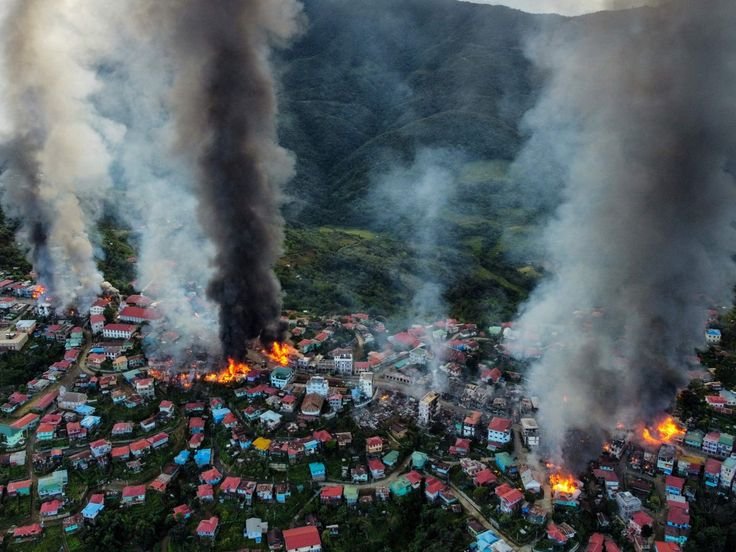Roads with buckles and heaps of rubble are making it difficult for aid to enter Myanmar. There have been 1,600 confirmed deaths so far, and more are anticipated.
One of several aftershocks that occurred on Sunday sent people in Mandalay, the second-largest city in Myanmar and the epicenter of Friday’s 7.7-magnitude earthquake, screaming into the streets as rescuers were still removing survivors from the debris.
One of the world’s poorest nations, already reeling from the horrific toll of four years of civil war, is now dealing with the humanitarian crisis of a strong earthquake that has killed at least 1,600 people and counting, as aid tries to reach those in need despite damaged infrastructure and buckled roads.
As the civil war and the natural disaster collided, Myanmar’s ruling military junta persisted in dropping bombs, further injuring people and intensifying the situation.
The nation’s vital services have been rendered inoperable by Friday’s earthquake, which has also rendered crucial sections of its roads impassable. Hospitals are overburdened and experiencing a shortage of blood and medical supplies.
The entry of aid into the most affected areas of Myanmar is being slowed by piles of debris and badly damaged roads, including the one that runs north to Mandalay from Yangon, the country’s largest city, and Naypyidaw, the capital, further complicated by “telecommunications and internet disruptions,” according to the UN’s humanitarian aid office.
According to the U.N., immediate needs include supplies for food, clothing, blankets, kitchenware, emergency shelters, water, sanitation, and hygiene. “Hospitals and medical facilities have been severely damaged or destroyed.”

Residents and rescuers are searching through the rubble for survivors as aid begins to arrive.
Chinese rescuers were seen working through the night in Naypyidaw in video that Reuters verified. They sift through the debris of a fallen building with their hands and shovels before removing an elderly person who is hardly conscious from the debris.
Rescuers retrieved a woman, crying, from the wreckage of the Sky Villa Condominium in Mandalay, which had collapsed and trapped dozens of people. The BBC’s Burmese service reports that nine bodies have been found and 29 people have been rescued from the complex.
The United Nations said in a statement on Saturday that “thousands of people are spending the nights on the streets or open spaces due to the damage and destruction of homes or fearing further quakes.”
A few nations have stepped up to support Myanmar’s emergency response.
According to state news agency TASS, Russia sent two planes carrying 120 rescuers and supplies, while the Chinese Embassy posted on Facebook that it had sent a team of 37 people to Yangon with supplies and medication to find survivors.
Reuters reports that teams from Thailand, Singapore, and India are also on the ground.
Drones buzz over the mountain of dust and twisted rebar that was once a 30-story building in neighboring Thailand, where dozens are still missing and several people have died, looking for signs of life.
Seven people were rescued alive within 24 hours of the earthquake, according to rescue teams on the ground, and as of Sunday, no one had been rescued. According to Chadchart Sittipunt, the governor of Bangkok, there are currently traces of life in the wreckage.
But the rescue operations could be slowed down by the rain. Family members of those trapped inside the building remain at the scene more than 48 hours after it collapsed, keeping watch and hoping that more missing people will be located soon.
Four men wearing some camouflage carried a suitcase and bags of equipment into the search area as part of a group of U.S. Air Force personnel who traveled from Japan to Bangkok on Sunday.
One of them said to the Next Tech Plus News crew on the ground, “We are here to help with the rescue effort.”
However, on top of the pre-quake crises, Myanmar has suffered the most from the catastrophe.
The International Rescue Committee reports that there is an urgent need for humanitarian assistance for over 19 million people.
According to the World Food Programme, 15.2 million people in Myanmar are food insecure. In response to attacks on healthcare facilities and medication blockades, the U.N. Security Council voiced concern last year about the “denial of access to medicine and medical care.”
Four years ago, the democratically elected government of Nobel Prize winner Aung San Suu Kyi was overthrown by a military coup. As the junta attempts to crush armed rebel groups, such as the National Unity Government (NUG), Myanmar’s government in exile, the nation has been engulfed in civil war ever since.
The NUG declared on Saturday that “offensive military operations, except for defensive actions,” would cease for two weeks in areas affected by the earthquake. However, the junta has not done the same.
Less than three hours after the initial earthquake, an airstrike in Naungcho, in the northern Shan state, killed seven people, according to BBC Burmese.
According to the BBC, pro-democracy rebel groups attempting to overthrow the military also reported aerial bombings in Chang-U township in northwest Sagaing, close to the earthquake’s epicenter.
U.N. special rapporteur for Myanmar Tom Andrews demanded a halt to military conscription and an “immediate ceasefire.”
He stated on X on Sunday that “aid workers should not have to fear arrest and there should be no obstacles to aid getting to where it is most needed.” “Every moment matters.”
Bombs are still falling on a nation that is still counting its dead as of right now.


